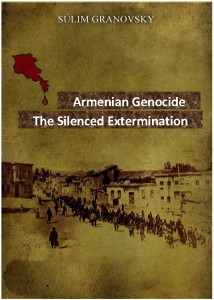The Raoul Wallenberg Foundation presents the ebook “Armenian Genocide. The silenced extermination”, an English version of the original in Spanish by the Argentinian author Sulim Granovsky.
Edited and published by our foundation in 2010 (Spanish ebook format), the research focuses on the tragic events that took place in 1915. As all the works that comprise the RWF Digital Library, this new ebook is freely accessible to all.
Sulim Granovsky comments on his creation in his own words: “Six hundred years of peaceful coexistence had elapsed within the empire, where Armenians shared in managing finance, business and the exports. Most of the buildings in Constantinople were built by Armenian architects. The main mosques were also the work of Armenian architects. Armenian officials advised the Turkish hierarchy. However, it was a false peace, because a series of vicissitudes anticipated the end of the precarious harmony, prior to the 1915 Genocide. In just a couple of years since 1895 Abdul Hamid, the Red Sultan, named after his bloodthirsty intentions, unleashed the annihilation of 300,000 Armenians. During the Hamidian era “any Muslim had permission to test the sharpness of his sword on the neck of an Armenian Christian.” Hamid’s murderous instinct was somewhat selective: he ordered the massacre of the Armenians in Anatolia, particularly if they had links to political parties and religious missions that could pose a threat to his regime because of the strong influence they had over the people. Truth is that in 1908 the rising movement of the Young Turks had overthrown Hamid, generating the support of the Armenians. However, the charm did not last long, because in the course of secret meetings of the Union and Progress Party, the Young Turks resolved that the Armenians were internal enemies of the Turkification process and should be persecuted and annihilated. The Interior Minister, Talaat Pasha, considered that, since the Armenians “had lost the right to life in the Ottoman Empire”, not a single bullet should be wasted in a holy war and, therefore, they should be killed with knives or drowned in the Euphrates. And this was what was done.”
This edition in English, commissioned to prestigious translator Elizabeth Birks, excels not only as a splendid translation, but also as a model of rhetorical precision.
At the same time we wish to take this opportunity to remind our readers of a recent initiative by the Raoul Wallenberg Foundation in connection with a special chapter dedicated to Turkish and Kurdish rescuers who, scattered around the Ottoman Empire, reached out to save Armenians during the 1915 Genocide. The exclusive research, assigned to and conducted by Professor Taner Akcam, renowned scholar who chairs the Armenian Genocide Studies at Clark University (Worcester, Massachusetts), comprises 73 pages. The work was originally edited in Turkish and later translated into English, Armenian and Spanish. So far, 180 individuals have been identified as rescuers, and we are still working to unveil further cases.
Remembering and recognizing the past is of utmost importance. For decades we have dealt with the luminous side of the Holocaust, highlighting the legacies of those heroes, women and men, who risked their lives to save the victims of the Nazi regime. We intend to approach the Armenian Genocide in the same positive way.
It is our genuine desire that the work of Mr. Granovsky may be useful for school students, scholars and the general public alike.
Eduardo Eurnekian
Chairman
Baruch Tenembaum
Founder
Click here and get the ebook free “Armenian Genocide. The silenced extermination”

